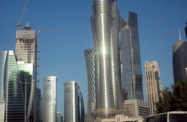Qatar looks set to retain its position as the world’s fastest-growing economy this year, with the country’s core sectors performing strongly and diversification continuing apace. While many economies worldwide are still sluggish, or face the prospect of slipping back into recession, Qatar is expected to see 21% real growth in 2011, according to a recent report by Doha-based financial institution QNB Capital.
Qatar was the world’s fastest-growing economy between 2006 and 2010, with a compound annual growth rate (CAGR) of 15.7%, according to QNB Capital, and the institution expects this to continue in 2011 as well.
QNB Capital, part of Qatar National Bank, has said public investments in the natural gas industry and other sectors have helped drive both “rapid growth and diversification of the economy”. The non-hydrocarbons economy achieved a CAGR of 16.4% between 2006 and 2010, with sectors such as manufacturing, financial services and construction expanding rapidly.
Even as economies around the world were hit by the slowdown in 2009, Qatar saw real GDP growth of 8.6%, according to the International Monetary Fund (IMF). And though this number was down from 25.4% the previous year, it is a rate that would still be considered remarkable by most countries, even in an excellent year.
As the IMF noted in March, Qatar “weathered the global financial crisis exceptionally well”. The organisation praised the authorities’ rapid counter-cyclical policy response, which included continued increases in gas-processing capacity, as well as support for the banking system and a demand-stimulus rise in public spending.
Having survived the international economic storm largely unscathed, Qatar is now strongly positioned to continue its rapid ascent, even amid concerns surrounding the US economy’s health, the eurozone’s stability and the sustainability of China’s GDP growth. These are considerable risks, but Qatar is nonetheless in an enviable situation. Its financial system is well capitalised and has low levels of non-performing loans. The government is also able to spend heavily at a time when others are tightening belts. Public expenditure, much of it geared towards the upcoming 2022 FIFA World Cup, is both providing much-needed infrastructure and services and helping to sustain momentum when global demand slackens.
QNB Capital forecasts the Qatari oil and gas sector will expand by almost a third in 2011, growing 29.5%, an increase driven largely by natural gas, a mainstay of the economy. Qatar is continuing to expand production of liquefied natural gas (LNG), a field where it is a world leader. Its LNG capacity is expected to rise to 77m tonnes by the end of the year, from 62m tonnes in 2010.
Crude oil output will grow more modestly, from 780,000 barrels per day (bpd) to around 800,000 bpd. Though this output is below the country’s overall production capacity of 1m bpd – as Qatar is restricted by OPEC commitments – the extra capacity cushion does give it the ability to ramp up crude output substantially if world supply falls short.
The non-oil and gas sector is forecast to grow 14.1%. A number of new petrochemicals projects are under way that will support the expansion of the value-added economy. Qatar is focusing on diversification and increasing exports of processed goods over raw materials, keeping more value local.
The construction sector’s resurgence will also be key for non-hydrocarbons growth. Private sector demand for homes, office space and industrial developments will be partnered with huge government investments in infrastructure and social facilities, such as schools and hospitals. Projects worth $185bn are expected to be executed over the coming decade.
The IMF forecasts 9% non-hydrocarbons growth from 2012 to the end of 2015, and points out that, since Qatar plans to stop expanding its gas capacity after 2012 to prevent oversupply, other sectors will by necessity become increasingly important for driving the economy forward and boosting external competitiveness.
With growth so strong, one of Qatar’s biggest economic challenges has been inflation. Qatar’s dollar peg limits its ability to head off inflationary pressure with monetary policy, so inflation remains a risk, particularly with demand stimulus from government and private spending. However, though inflation reached 15% in 2008, both 2009 and 2010 were actually deflationary when measured by the consumer price index.
Indeed, the inflation rate remains relatively low, at an annual 1.9% in July. Analyst forecasts see this rising to 3.2% for full-year 2011 (the IMF expects 3%), which is not particularly high given a 20%-plus GDP growth rate. Qatar’s sizeable housing stock means supply has kept pace with demand, unlike in many other emerging markets where tight housing markets have led to rental inflation. On the contrary, Qatar’s economy does not appear to be overheating and is in fact primed for continued healthy expansion.

